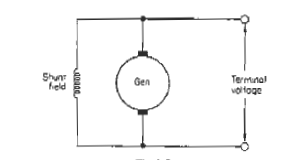Self excited Shunt wound generators
- Subhajit Debnath
- Dec 3, 2024
- 2 min read
Updated: Dec 11, 2024
Introduction
Shunt-wound generators are one of three types in the self-excited class of machine and are used in aircraft d.c. power supply systems, The term "shunt-wound" is derived from the fact that the high-resistance field winding is connected across or in parallel with the armature.
The armature current divides into two branches, one formed by the field winding, the other by the external circuit. Since the field winding is of high resistance, the advantage is gained of having maximum current flow through the external circuit and expenditure of unnecessary electrical energy within the generator is avoided.

Operating Principle & Characteristics
When the armature is rotated the conduators cut the weak magnetic field which Is due to residual magnetism in the electromagnet system. A small e.m.f. is induced in the armature winding and is applied to the field winding, causing current to flow through it and so increasing the magnetic flux. This, in turn, causes a progressive increase in the induced e.m.f. and field current until the induced e.m.f. and terminal voltage reach the steady open-circuit maximum.
The terminal voltage tends to fall with Increasing load current. This is due to the voltage drop (IR drop) in the armature winding and also to a weakening of the main flux by armature reaction.
The fall in terminal voltage reduces the field current, the main flux is further weakened and therefore a further fall in terminal voltage is produced. If the process of increasing the load Is continued after the full working load condition has been reached, the terminal voltage will fall at an increasing rate until it can no longer sustain the load current and they both fall to zero.
With reduced excitation the external characteristic of a shunt-wound generator falls much more rapidly so that the point at which voltage collapse occurs will be reached with a much smaller load current. In practice, field current is adjusted to maintain constant voltage under all load conditions, by a voltage regulator.
Sometimes a generator will lose its residual magnetism or become incorrectly polarized because of heat,
shock, or a momentary current in the wrong direction. This can be corrected by momentarily passing current
through the field from the positive terminal to the negative terminal; a procedure known as "flashing the
field".




Comments